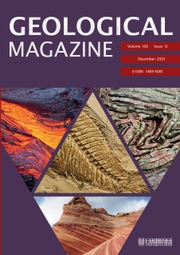Article contents
I.—On Nepheline-Syenite and its Associates in the North-West of Scotland
Published online by Cambridge University Press: 01 May 2009
Extract
In 1892 I described, in conjunction with my colleague Mr. Horne, a peculiar rock, essentially composed of orthoclase and melanite, under the name of borolanite. The type-specimens came from the plutonic mass which lies to the north of Loch Borolan, in Sutherlandshire (1 in. sheet 101). During the preparation of the paper on borolanite our colleague Mr. Gunn discovered two dykes of a closely related rock traversing the Torridon Sandstone in the Coigach district of West Ross-shire. The rock of these dykes was described in an appendix to our paper. It contains nepheline and ægirine, in addition to orthoclase and melanite, and is therefore allied, both as regards mode of occurrence and mineralogical composition, to the Tinguaite group of Rosenbusch; but as melanite is an important constituent it was classed with the borolanites.
- Type
- Original Articles
- Information
- Copyright
- Copyright © Cambridge University Press 1900
References
page 385 note 1 “On Borolanite: an Igneous Rock intrusive in the Cambrian Limestone of Assynt, etc”: Trans. Roy. Soc. Edin., vol. xxxvii (1892), pp. 163–178.Google Scholar
page 386 note 1 Mineralogical Magazine, vol. v (1884), p. 141.Google Scholar
page 386 note 2 A specimen in the Survey collection (3,081) from the summit of Cnoc na Sròine shows a half-porphyritic structure such as is occasionally found on the margin of Brögger’s nordmarkite.
page 386 note 3 The numbers in parentheses refer to the registered specimens in the collection of the Geological Survey.
page 387 note 1 It may be of interest to mention that in the metamorphic rocks (albite-schists and gneisses) I have always found the albite to give the theoretical extinction of 19° on M-flakes. The mineral appears to be perfectly homogeneous and ideally pure, except as regards inclusions. But I have never observed the theoretical extinction of 19° in a plagioclase occurring as a normal constituent of an igneous rock. In the case above described the breadth of the band in the diffusion column, the zonal structure seen in the sections, and the slightly varying extinctions on the M-flakes, all indicate that the mineral is not perfectly homogeneous.
page 388 note 1 “The Igneous Rocks of Arkansas” : Annual Report of the Geological Survey of Arkansas for 1890, vol. ii.Google Scholar
page 388 note 2 “Igneous Complex of Magnet Cove” : Bull. Geol. Soc. Amer., vol. ii (1900), pp. 389–416.Google Scholar
page 389 note 1 “Die Gesteine von Jiwaara in Finland”: Geol. Foren. Stockholm Forandl., xiii, (1891), p. 300.Google Scholar
page 389 note 2 It is quite possible that some varieties of the melanite of the borolanite may be titaniferous, but in order to prove this the material analyzed would have to be very carefully examined under the microscope, as the mineral is not unfrequently crowded with minute inclusions of sphene.
page 391 note 1 “Notes on some Hornblende-bearing Rocks from Inchnadampf,” by Teall, J. J. H.: Geol. Mag., 1886, pp. 346–353CrossRefGoogle Scholar.
- 7
- Cited by


